Among the many cities in Europe, Vienna stands out as a bastion of rich and deeply rooted Jewish heritage. The Jewish community in Vienna has not only endured but thrived, making Vienna’s Jewish heritage sites some of the most abundant and culturally significant in all of Europe. The enduring and profound influence of the Jewish community on Vienna’s social, cultural, and political life cannot be emphasized enough. Throughout the 20th century, Vienna’s Jewish community boasted luminaries like Sigmund Freud, Gustav Mahler, renowned writers Stefan Zweig and Arthur Schnitzler, as well as Theodor Herzl, the visionary behind the modern Zionist movement. Notably, three out of the four Austrian Nobel Prize laureates were Jewish.
In the early 1900s, Vienna was home to a thriving Jewish population of 175,318 individuals, making it the third-largest Jewish community in Europe, following only Warsaw and Budapest. Jewish residents comprised a remarkable ten percent of the city’s total population, with a staggering 60 percent of its medical professionals being of Jewish descent. However, the tragic events of Kristallnacht in 1938 and its aftermath resulted in the complete destruction of twenty-four synagogues and approximately 40 smaller prayer houses. Shockingly, only one of these structures, the Stadttempel, constructed in 1826, managed to survive this devastating period in history.
Present-Day Jewish Life
Today, Vienna’s Jewish culture is experiencing a vibrant resurgence, despite the challenges it has faced. Much of this revival can be attributed to immigration from the East, which has gradually bolstered the Jewish population throughout the city. The district of Leopoldstadt, known for its diversity as Vienna’s Second District, notably boasts the highest Jewish population. Currently, Vienna is home to an estimated 15,000 to 20,000 Jewish residents, and the city hosts a rich tapestry of Jewish life.
Vienna now boasts 15 synagogues and a multitude of impressive Jewish landmarks, including the central Jewish Quarter. The city is also home to various Jewish institutions, such as the newly established IKG campus, the Lauder Chabad Campus, and the Jewish Vocational Education Center, as well as prayer rooms, mikvehs (ritual baths), and other religious educational facilities. However, these establishments may not be immediately discernible to passersby. Guard booths and concrete barriers outside nondescript buildings may provide subtle hints of their presence, indicating the presence of Jewish day schools or synagogues.

The Stadttempel: Vienna’s Main Synagogue – New York Jewish Travel Guide
In the Second District, a thriving Jewish community is evident through Jewish shops, kosher supermarkets, butchers, bakeries, restaurants, snack bars, and, in the vicinity of Tempelgasse, the Sephardic Center and Synagogue. Remarkably, the site that once housed the Leopoldstadt temple until 1938 is now the location of the ESRA psychosocial institution, which serves survivors of Nazi persecution and their descendants.
Furthermore, Vienna boasts a Jewish Institute for Adult Education at Praterstern, offering courses on Yiddish, kosher cooking, Israeli folk dancing, Klezmer music, and religious matters, providing non-Jewish individuals with an opportunity to learn more about Judaism.
As Cantor Shmuel Barzilai aptly expressed, “Jewish life in Vienna today is very colorful and lively. We have Reform, Sephardic, and Chasidic Jews. There are kosher restaurants and a dozen Jewish schools, and you can find all the products necessary to live a Jewish life.” Vienna’s Jewish community is undeniably thriving and diverse, contributing to the city’s rich cultural tapestry.
Exploring Vienna’s Jewish Legacy
Embarking on a journey into Vienna’s rich Jewish heritage often begins at the Jewish Museum, a focal point that not only delves into the city’s historical Jewish narrative but also provides a glimpse into contemporary cultural activities. This institution holds a significant place in history, as it was the world’s inaugural Jewish Museum, established in 1895 through the generous support of Viennese-Jewish patrons.
Located within the splendid Palais Eskeles at Dorotheergasse 11, nestled in the heart of Vienna’s First District, the museum offers an unconventional exhibition layout that offers a distinct perspective on Jewish history and remembrance. The museum’s permanent exhibitions are thoughtfully distributed across three distinct areas: the display depot, The Studio, and the “Our City!” permanent exhibition.
The museum’s library is a treasure trove, boasting a collection of 25,000 books in German, Hebrew, Yiddish, and English, which ranks it among the most distinguished libraries in all the European Jewish museums. The Teitelbaum Café, located near the entrance, provides a delightful experience with Austrian kosher wines, Viennese pastries, and a selection of vegetarian dishes. Additionally, the café features a bookstore brimming with books and catalogs, offering visitors a chance to delve further into the museum’s offerings and Vienna’s Jewish heritage.
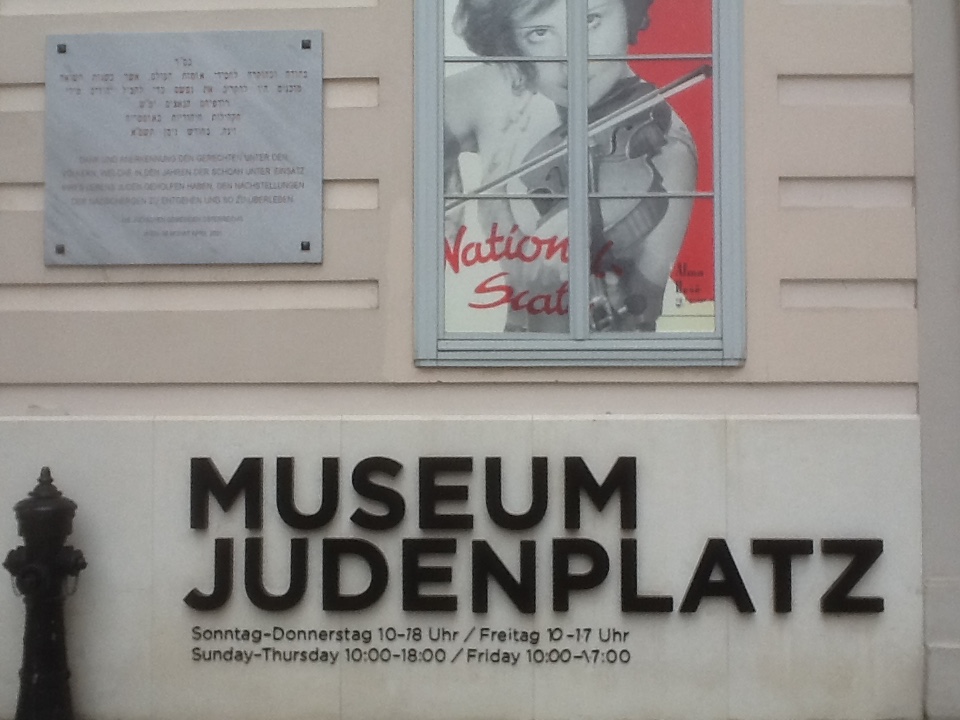
The Jewish Museum in Vienna – New York Jewish Travel Guide
The Jewish Museum extends its presence to Judenplatz, situated in the heart of Vienna’s medieval Jewish quarter. This location, inaugurated in 2000, is part of a comprehensive complex that also houses a Holocaust memorial, a poignant tribute to the 65,000 Austrian Jews who perished during the Shoah, and a Holocaust documentation center.
In 1420/21, Vienna’s medieval Jewish community suffered a devastating fate: severe persecutions, expulsions, brutal murders, and the tragic incineration of the Judenplatz synagogue, with Jews trapped inside. This tragic event resulted in the loss of countless lives as Jews found themselves trapped within the inferno. A poignant testament to this dark chapter in history is the 15th-century Latin plaque on the facade of the building at Judenplatz 2. It hauntingly commemorates these events, with an excerpt reading, “Thus arose in 1421 the flames of hatred throughout the city and expiated the horrible crimes of the Hebrew dogs.”
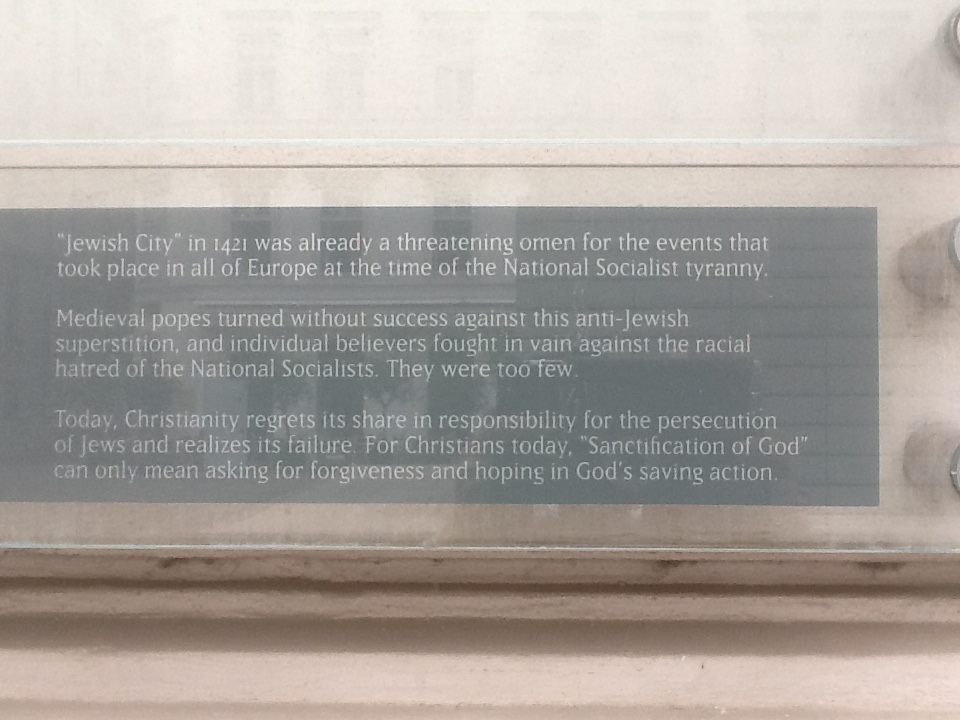
A 15th-century Latin Plaque at Judenplatz 2 – New York Jewish Travel Guide
The subterranean remnants of the synagogue were serendipitously discovered during excavations in the 1990s. Today, they serve as the nucleus of the Judenplatz Jewish Museum, offering visitors a profound glimpse into medieval Jewish life through a multimedia exhibit. This museum stands as a powerful testament to the enduring memory of Vienna’s Jewish heritage and the resilience of its people throughout history.
Above, at street level, presides the Holocaust Monument, a commanding structure fashioned from reinforced concrete, gracing the square known as the “Nameless Library.” This remarkable creation, crafted by British sculptor Rachel Whiteread, takes the unconventional form of an “inside-out” library, with rows of books with spines turned inward. A poignant inscription near the entrance reads, “In commemoration of more than 65,000 Austrian Jews who were killed by the Nazis between 1938 and 1945.” Additionally, the monument bears inscriptions of the names of the camps where Austrian Jews met their tragic fate.
In April 2001, an adjoining plaque was dedicated to honor the righteous Gentiles who, at great personal risk, valiantly saved Jewish lives during the Holocaust.
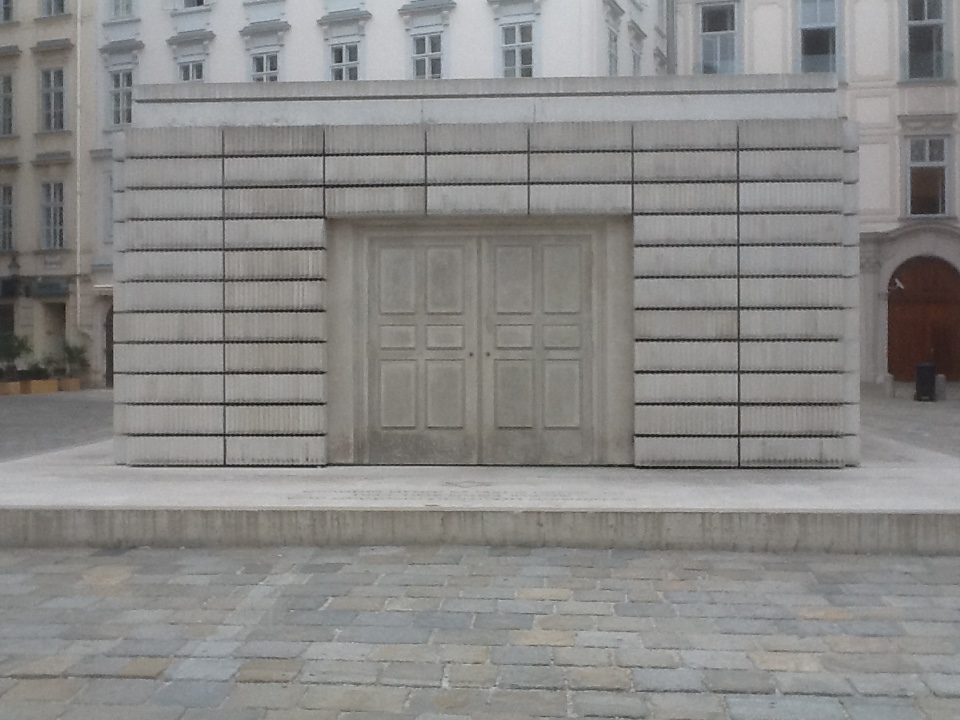
Rachel Whiteread Memorial – New York Jewish Travel Guide
Vienna boasts two museums that illuminate the profound Jewish heritage woven into the city’s cultural and intellectual tapestry: the Schoenberg Center and the Sigmund Freud House. The Freud Museum occupies the apartment where Freud practiced psychoanalysis and lived until 1938. It showcases personal artifacts and offers insight into his life and work. Nearby, the Arnold Schoenberg Center highlights the life and contributions of the modern Austrian composer with rotating exhibitions. As you stroll Vienna’s Ring Boulevard, you’ll pass grand mansions once owned by Jewish families, including Palais Todesco, Palais Schey, Palais Epstein, and Palais Ephrussi, each reflecting Vienna’s rich Jewish history.
The Jewish Welcome Service Center: A Gateway to Vienna’s Jewish Heritage
The Jewish Welcome Service Center serves as a vital resource for information about various aspects of Jewish life and cultural heritage in Vienna. It offers valuable insights into the city’s most significant Jewish communities.
During our tour, Ms. Beatrice Auymar shared a touching initiative with NYJTG. This project involves the placement of memorial stones on homes and sidewalks, right in front of residences where Jewish individuals once resided. These poignant “Stones of Remembrance” serve as powerful reminders of the Jewish inhabitants who tragically lost their lives during the Holocaust. Prior to this dark period, their culture and traditions played a vital role in Viennese life, leaving an indelible mark that continues to resonate today. These visible stones encourage passersby to contemplate this pivotal chapter in Vienna’s history and the invaluable contributions of its Jewish community.

Memorial Stones – New York Jewish Travel Guide
Morzinplatz: Remembering Gestapo Victims
Morzinplatz hosts a poignant memorial honoring the victims of Nazi tyranny during World War II. It features a bronze sculpture and a granite block from Mauthausen, symbolizing the fate of these victims. The inscription reads, “Here stood the House of the Gestapo. For those who believed in Austria, it was hell. For many, it was the gate to death. It sank into ruins just like the ‘Thousand-Year Reich.’ But Austria was reborn, and with her, our immortal victims.” This solemn memorial serves as a reminder of the tragic history and the resilience of those who suffered during this period.
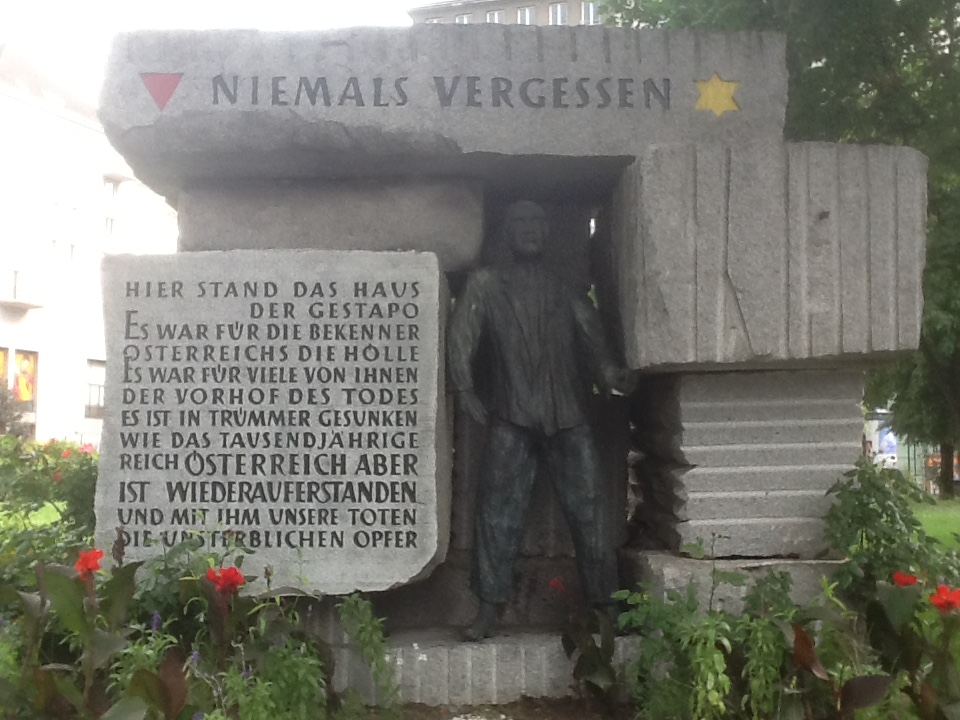
Monument to Fascism Victims in Morzinplatz – New York Jewish Travel Guide
The Stadttempel: Vienna’s Sole Survivor
The Stadttempel, also known as the Seitenstettengasse Temple, stands as Vienna’s principal synagogue today. Tucked away in the former Jewish quarter along the sloping Seitenstettengasse, it is a testament to a unique historical period. Surprisingly, this synagogue does not boast a grand entrance. It was constructed in 1824 when Emperor Franz Josef mandated that all non-Roman Catholic places of worship be discreetly hidden from public view. Nestled between two residential buildings, it lacks an ornate façade, yet it holds a remarkable distinction—it is the sole survivor among the 94 Viennese synagogues that escaped Nazi destruction.
This exquisite synagogue was the creation of the esteemed architect Josef Kornhäusl, renowned for his work in theaters. He crafted the Stadttempel with a circular design reminiscent of an Italian-style Baroque opera house, complete with a stage, three balconies, wings, and a foyer, showcasing his architectural prowess and reverence for design.

The Main Synagogue: The Stadttempel – New York Jewish Travel Guide
The building complex encompasses more than just the synagogue; it serves as a multifunctional hub. Within its walls, you’ll find the offices of the Vienna Jewish Community, the Vienna Chief Rabbi, the editorial team of the official community newspaper, Die Gemeinde (The Community), a vibrant Jewish community center hosting diverse events, the Library of the Jewish Museum, and a kosher restaurant named Alef-Alef.
One notable aspect distinguishing the synagogue today is the presence of armed guards stationed outside. To visit this magnificent sanctuary, you’ll need to bring your passport for entry, and scheduled entry times are available from Monday to Thursday at 11:30 a.m. and 2 p.m., subject to rigorous security checks.
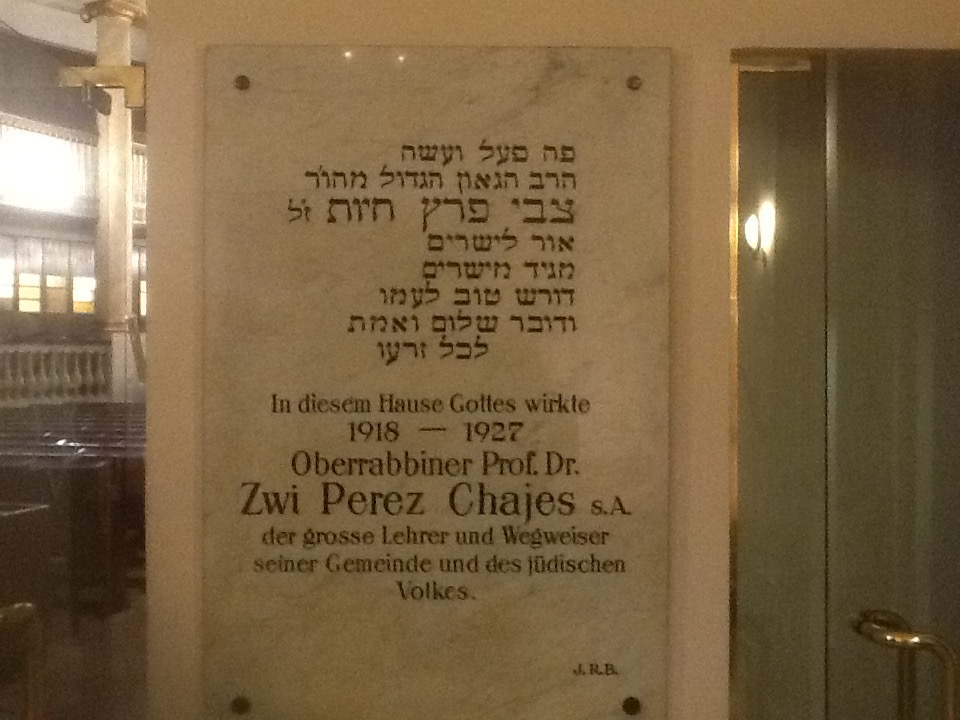
The Main Synagogue: The Stadttempel – Commemorative Plaque of the Chief Rabbi of the Jewish Community of Vienna – New York Jewish Travel Guide
Exploring Leopoldstadt: Vienna’s Historic Second District
Wandering through Leopoldstadt, Vienna’s Second District, located just across the Danube Canal from the city center, offers a unique glimpse into the district’s rich Jewish heritage. Before the devastation of World War II, this area was home to approximately 60,000 Jews, constituting one-third of Vienna’s Jewish population. Leopoldstadt was replete with synagogues, Jewish theaters, schools, and various other Jewish institutions, earning it the moniker “Mazzes-Insel” or “the Matzo Island.”
This district was also a central European stronghold of both Zionism and Chasidism. While many of these historical sites have vanished over time, you’ll encounter plaques lining the streets and Stolpersteine, commemorative stumbling blocks that mark significant locations. For instance, you may come across the remains of a synagogue destroyed during Kristallnacht, where only four columns remain. In its place, ESRA stands—a center dedicated to counseling victims and witnesses of the Shoah (Holocaust) and combating racism.
At number 7 on the same street, you’ll find the Sephardic Center, which serves as a hub for associations of Jews hailing from Bukhara, Georgia, and their respective synagogues. Leopoldstadt, once a vibrant hub of Jewish life, still bears poignant traces of its past, offering a moving tribute to its history and the resilience of its people.
Hrdlicka Memorial: A Powerful Anti-War Statement
Near Vienna’s Opera House, the “Monument against War and Fascism,” crafted by artist Alfred Hrdlicka, commands attention with its striking presence. Within this monumental installation, you’ll encounter an array of symbolic sculptures, with one particularly striking element: a bronze representation of a bearded Jewish figure, bound by barbed wire and forced into the task of street scrubbing. The granite used in the monument comes from the former Mauthausen concentration camp, located west of Vienna.
The stone itself bears sculptures representing concentration camp victims on one side and Austrian soldiers lost in World War II on the other. After its installation in 1988, some tourists mistakenly used the sculpture as a bench for picnics, leading to the addition of barbed wire around the Jewish figure to prevent further misunderstanding. The Hrdlicka Memorial serves as a powerful reminder of the devastating impact of war and fascism.
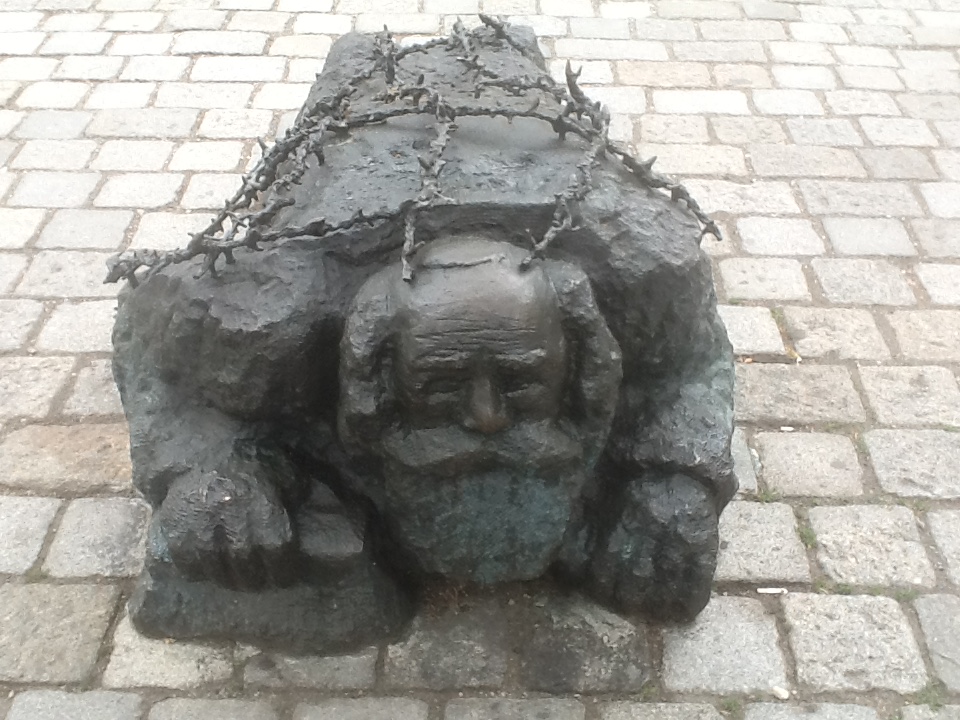
“Monument against War and Fascism”- New York Jewish Travel Guide
Jewish Cemeteries: A Glimpse into Vienna’s History
Vienna boasts five remarkable Jewish cemeteries, each holding historical and artistic significance. Among them is the Rossau Cemetery, one of the city’s oldest and most beautiful. It was founded in 1540 and served as a Jewish hospital from 1698 to 1934. The cemetery features tombstones dating back up to 500 years, some with elegant calligraphy, lengthy epitaphs, and intricate carvings of Jewish symbols and floral motifs. Prominent Jewish Viennese residents, such as Rabbi Sabbatai and banker Samuel Oppenheimer, rest here. The most imposing mausoleum is Wertheimer’s tomb, an intricately carved white structure.
The vast Zentralfriedhof, or Central Cemetery, established in the 1870s, includes a substantial Jewish section with around 100,000 burials. It showcases stately tombs and mausolea, reflecting the community’s prosperity. The cemetery features a cenotaph in honor of Theodor Herzl, the visionary Zionist leader whose remains were later moved to Mount Herzl in Jerusalem. Herzl’s will expressed his desire for a simple funeral and to be buried in Israel when the Jewish people could do so. Today, the Doebling Cemetery in Vienna houses his cenotaph, commemorating his significant role in the Zionist movement.
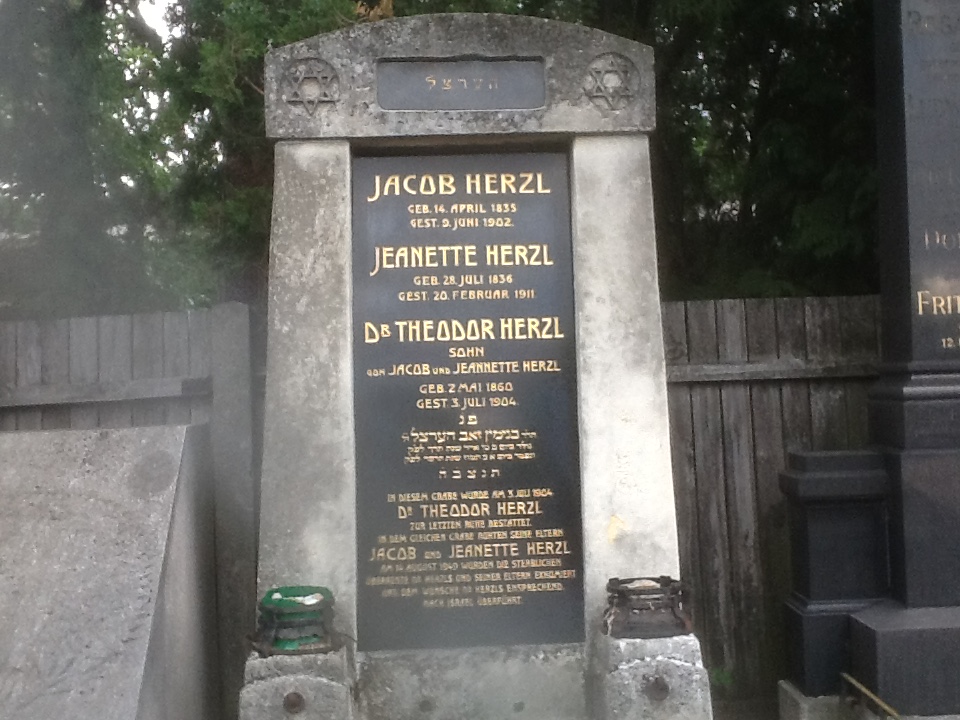
Theodor Herzl‘s – New York Jewish Travel Guide
Vienna: Must-Visit Sites
The Vienna Hofburg: Austria’s Imperial Palace
The grand Hofburg Palace in Vienna, a former seat of Austria’s Habsburg monarchy, now serves as the venue for presidential state affairs. This extensive complex sprawls across 59 acres, housing 19 courtyards, and 2,600 rooms, complemented by squares and gardens. Highlights include the Imperial Silver Collection, offering a glimpse into lavish imperial banquets, and the Sisi Museum, which delves into the life of Empress Elisabeth. Visitors can also explore the Imperial Apartments, a series of 19 rooms once occupied by Emperor Franz Joseph and his consort.
Now, head towards Vienna’s main pedestrian street, the Graben. En route, you’ll encounter St. Stephen’s Cathedral, an iconic Gothic masterpiece, and Vienna’s most famous landmark. Its majestic towers have dominated the city’s skyline for centuries. Notably, it was here in 1893 that Theodor Herzl, the visionary behind the modern state of Israel, first conceived the idea of a mass public conversion of Jews to counter growing Judeophobia in the city.
At Stephan Platz, Vienna’s central square, St. Stephen’s Cathedral stands as a remarkable focal point, surrounded by a captivating blend of architectural styles that harmoniously merge the old with the new. It’s a delightful spot to relax, watch people, and savor a coffee on one of the charming café patios.
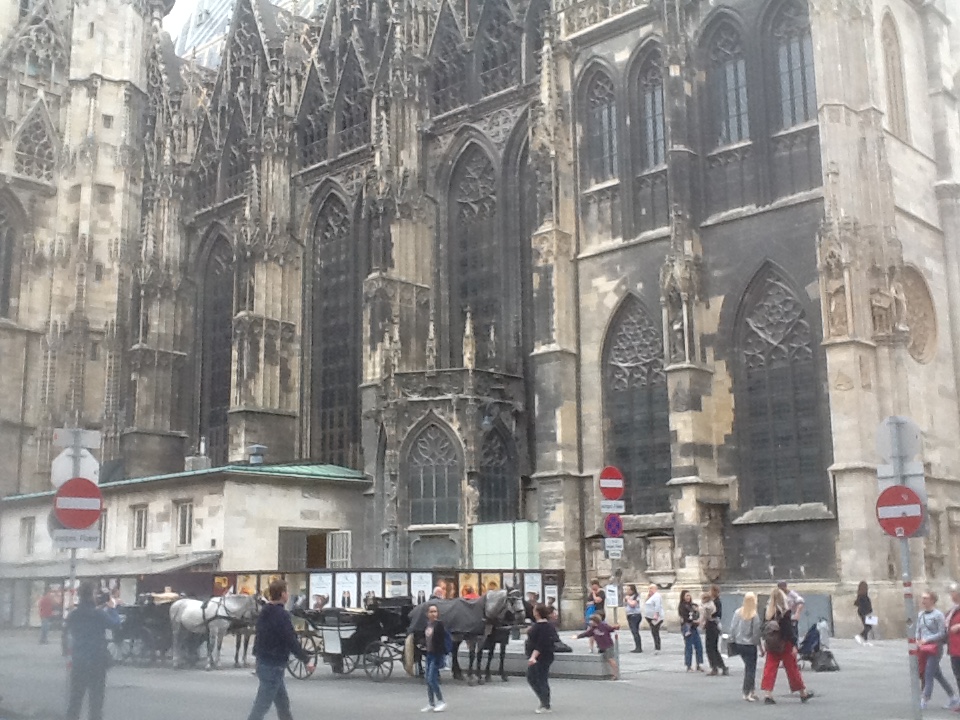
St. Stephen’s Cathedral – New York Jewish Travel Guide
Vienna State Opera House: A Musical Marvel
The Vienna State Opera House, among the world’s grandest theaters, has hosted legendary composers, conductors, soloists, and dancers. It hosts over 300 operatic and ballet performances each year, showcasing a musical heritage dating back to 1625, when the first Viennese Court Opera took the stage.
Cafe Demel: A Culinary Treasure
Established in 1786, Cafe Demel is not only Vienna’s oldest café and bakery but also a place for an unforgettable culinary experience. Here, dishes and pastries are meticulously handcrafted following traditional recipes. The attentive Demelinerinnen, the waitstaff who maintain the formal greeting “Haben Schon gewählt?” (Have you already chosen?) are a distinctive feature. Equally enticing are the exquisite cakes and pastries (not kosher) displayed, often resembling figures and creatures from history and mythology, each a true work of art.
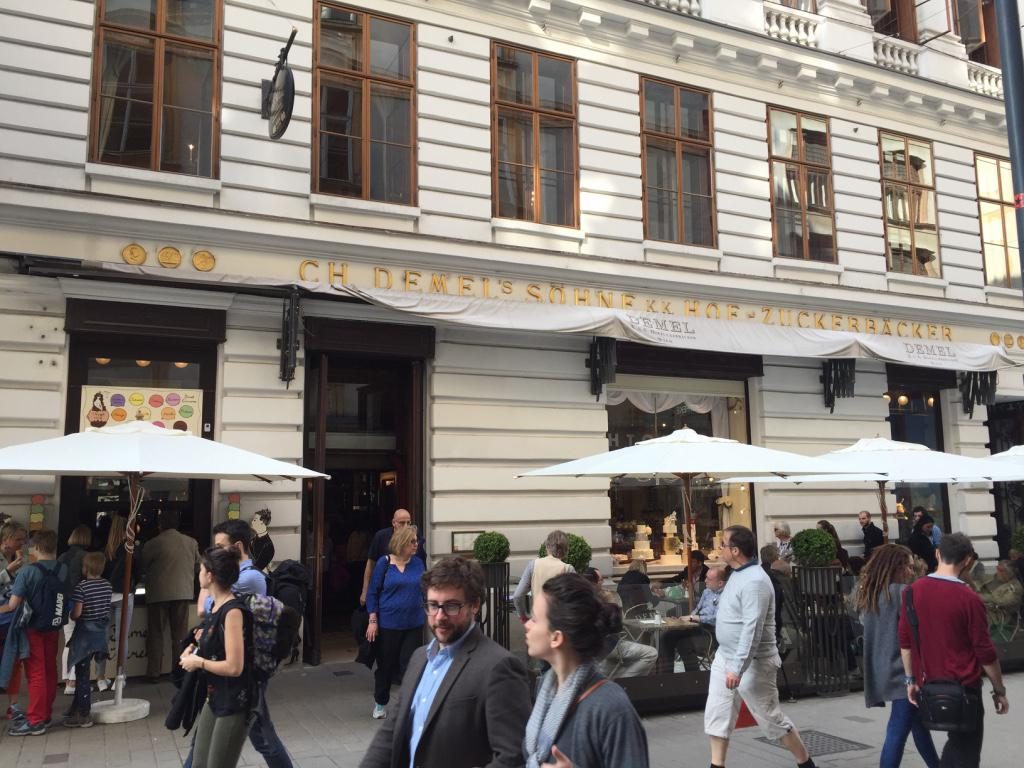
Cafe Demel – New York Jewish Travel Guide
Vienna’s Natural History Museum: A Fascinating Journey
Vienna’s Natural History Museum is a captivating destination renowned for its vast Dinosaur Hall and the world’s largest collection of meteorites, including the Tissint meteorite from Mars that landed in Morocco in 2011. With 39 exhibit halls, it delves into topics like human origins, cultural evolution since prehistoric times, and more. The museum’s latest addition is a state-of-the-art digital planetarium featuring full-dome projection, offering an immersive experience for visitors.
For more information:
To plan a trip to Austria, contact the Austrian National Tourist Office or log on to:
Story and photography by Meyer Harroch, New York Jewish Travel Guide, and New York Jewish Guide.com
The author took part in a press trip sponsored by the Austrian National Tourist Office.



You must be logged in to post a comment Login